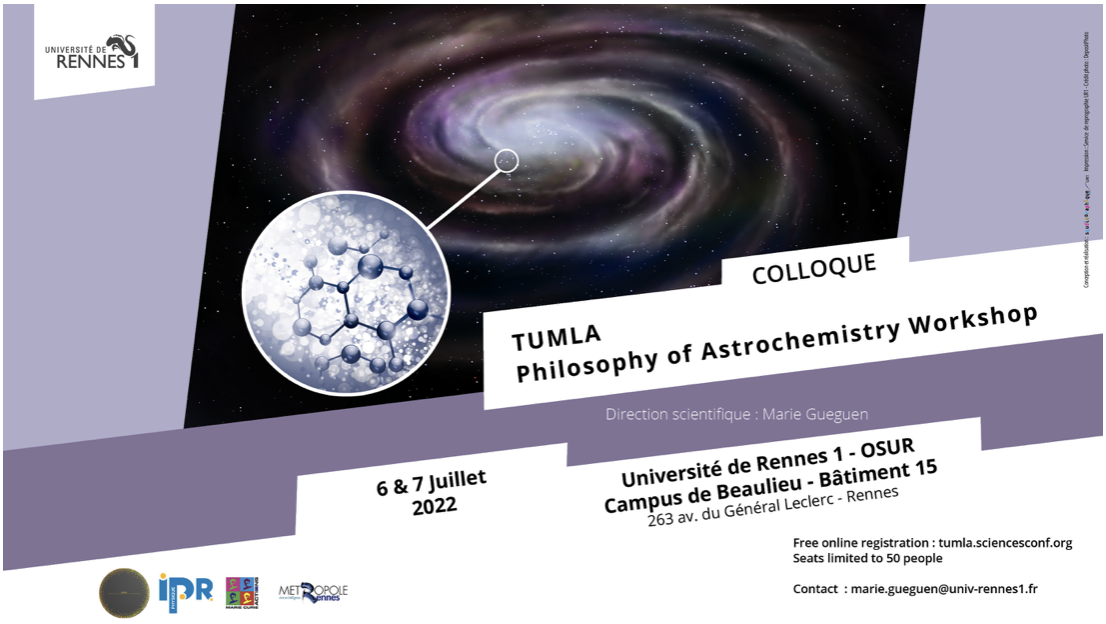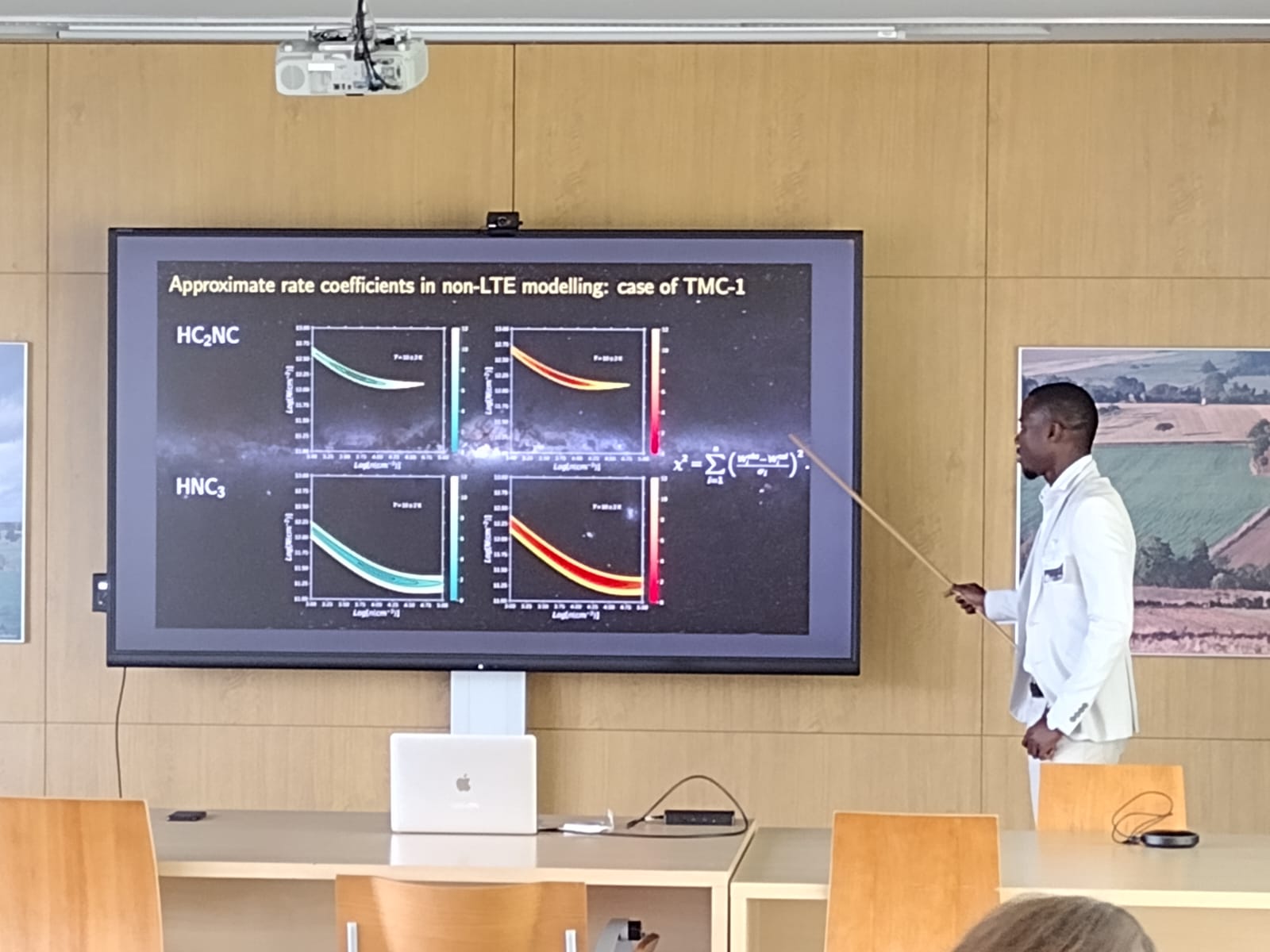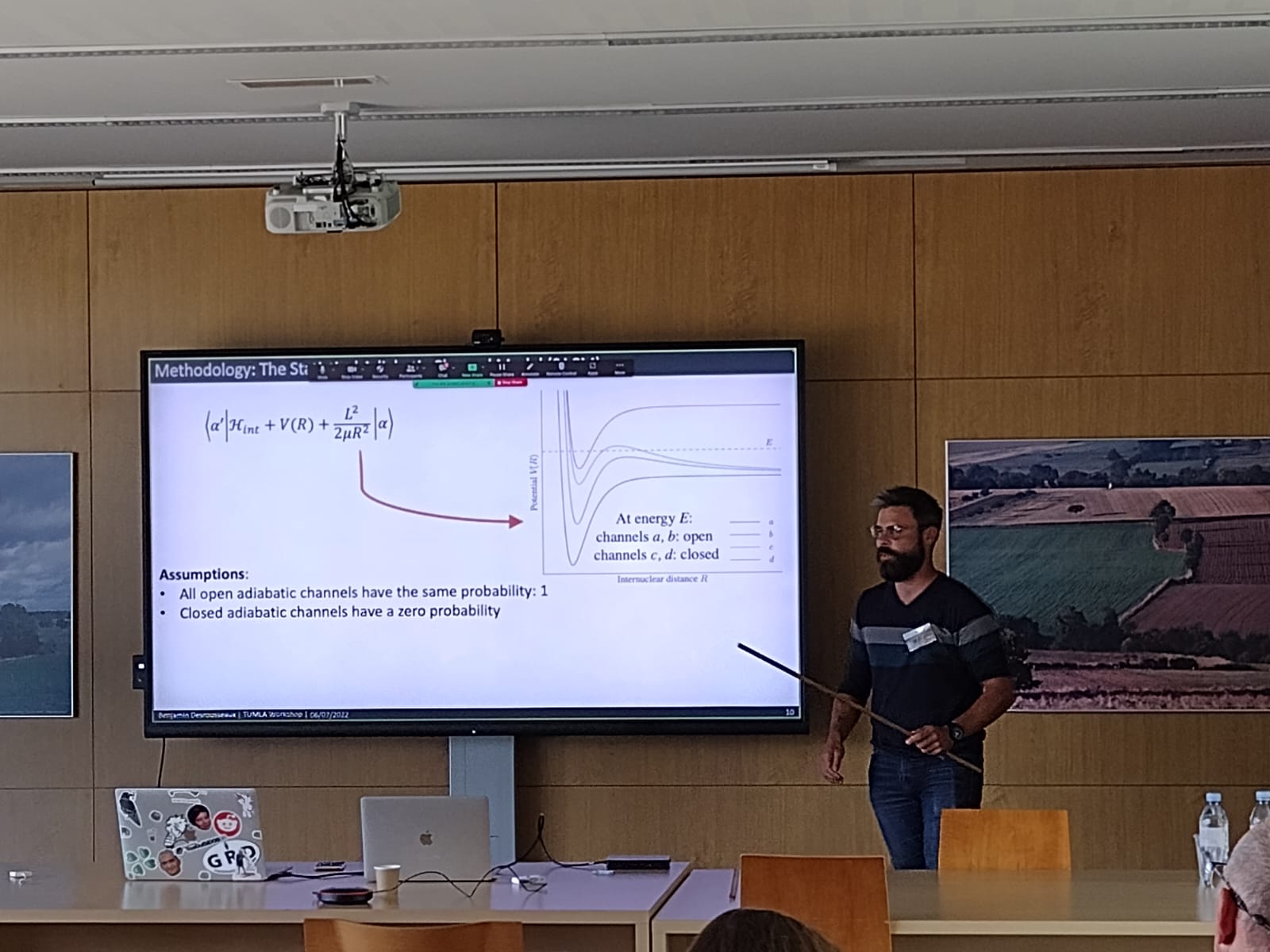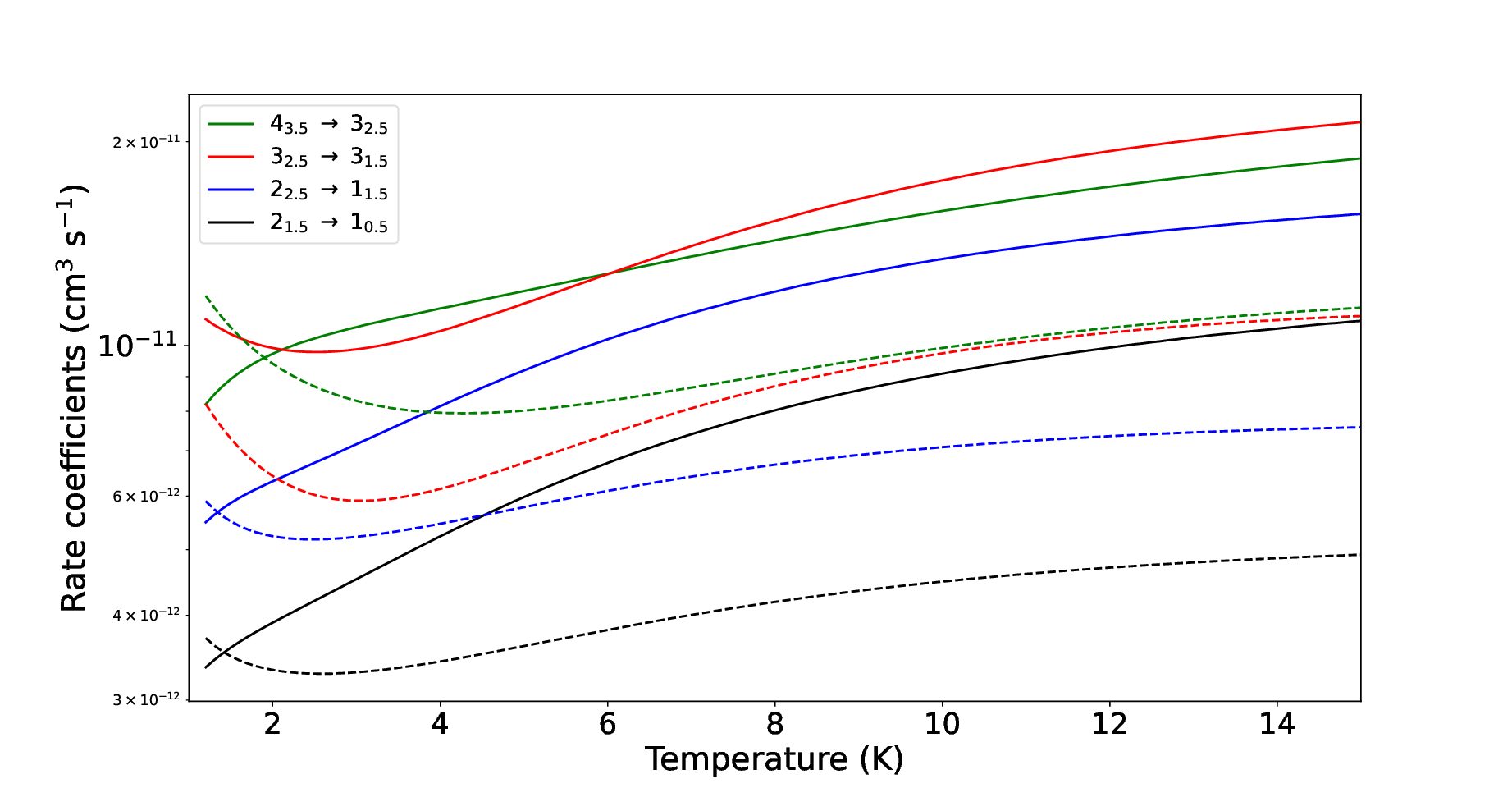by Marie Gueguen & Amélie Godard Palluet & Benjamin Desrousseaux & Cheikh Bop & Michał Żółtowski & Sándor Demes & Paul Pirlot Jankowiak, on
Presentation of the conference

The goal of this workshop is to present and discuss the main difficulties that can hinder interdisciplinary work in astrochemistry, taking as a starting point the communication of incertainties across different domains - from theoretical calculus providing collisional data to chemical models and to experimental laboratory astrophysics.
Marie Gueguen organized this conference, and all the present members were part of the organizing committee.
M. Gueguen, C. Bop, S. Demes, B. Desrousseaux, M. Żółtowski, A. Godard Palluet and P. Pirlot Jankowiak presented their work in oral communications.
Extending the loop: model evaluation and discordances in astrochemistry - M. Gueguen
I present different strategies for evaluating the adequacy of a model in context of high uncertainties, all based on the idea of iterative coherence testing, i.e., a methodology that anchors the improvement of the model’s accuracy in an iterative process of solving the discrepancies between the model’s predictions and observations. Based on Le Quéré (2006), I consider three different phases of the development of a model and how iterative conference testing, or “the closing the loop” methodology in G.Smith’s terms, can guide decisions for improving the model for each one of these phases. I argue that iterative testing serves a different purpose and is connected to a different evaluation strategy at each phase of the development of a model, from the adoption of a initial model known to be imperfect to a mature model ready to be confronted to observations.
I will illustrate the merits and pitfalls of such an account of iterative testing and model evaluation based on the example of the photochemical models of Titan’s atmosphere developed over the last two decades. Models of Titan's atmosphere have roughly followed two very different paths: either they have started with a complex chemical model but simplified astrophysical constraints, or with a complex description of the astrophysical conditions but a simplified chemistry. Both, however, failed to reproduce observations, although uncertainties attached to observations made the discordance not so worrying, until the observations of the Cassini-Huygens' mission were released in 2007. The latter showed that the discrepancies were not dampened, but on the contrary worsen by improved observations: the uncertainty attached to the model were shown to be higher than those related to observations, rendering the comparison between observations and models impossible to interpret. This case has led to an impressive surge of creativity from the astrochemists, who have exploited this opportunity to develop innovative iterative tools designed to enrich and develop their photochemical network to the point where a discordance between their chemical models and the Cassini's observations could finally be significantly interpreted.

Non-LTE modelling of the HCCNC and HNCCC abundance in astrophysical environments - C. Bop, A. Faure , E. Quintas-Sánchez, R. Dawes, and F. Lique

The isomers of HCCCN, namely HCCNC and HNCCC, are widely observed in the interstellar medium and in circumstellar envelopes. Their abundance has been determined under the assumption of local thermodynamic equilibrium (LTE) conditions or non-LTE radiative transfer models, but considering the collisional excitation of HCCCN as the same for all isomers.
Chemical models for the prototypical cold cores, TMC-1 and L1544, reproduced the abundance of HCCCN fairly well, but they tend to overestimate the abundances of HCCNC and HNCCC with respect to the observations. It is therefore worth revisiting the interpretation of the observational spectra of these isomers using a rigorous non-LTE modelling. The abundance of HCCNC and HNCCC were then determined using non-LTE radiative transfer calculations based on the proper rate coefficients for the first time in this work. Modeling the brightness temperature of HCCNC and HNCCC when using their proper collision rate coefficients shows that models based on LTE or non-LTE with approximate collision data may lead to deviations of up to a factor of 1.5.
Reinterpreting the observational spectra led us to significant differences relative to the observed abundances previously determined. Our findings suggest quite similar abundance ratios for the TMC-1 and L1544 cold cores as well as the L483 protostar. This work will encourage further modeling with more robust non-LTE radiative transfer calculations and future studies to revisit the chemistry of HCCCN and its isomers in cold molecular clouds.
Is it worth to investigate such phenomena, which are predictable with a good accuracy ? - S. Demes, and F. Lique
Astronomy and astrophysics are fields of science, which evolves rapidly due to the technological progress. The recent telescopes allow one to carry out observations very efficiently, giving a possibility to look into various regions of the Universe. In order to correctly interpret the observations, however, complementary research is required: laboratory measurements and/or theoretical modelings. For instance, when molecular species are observed in Space, there is a need for precise collisional and spectroscopic data in order to correctly describe the physical conditions of the astronomical environment, from where it was detected.
Very often the spectroscopic and especially the collisional data are challenging to get, both from experimental and also from theoretical perspective. The calculation of collisional rate coefficients could be calculated only from sophisticated quantum-theories. Such calculations are very computationally demanding, so one should carefully choose the boundaries of calculations (e.g. making limitations on energy, temperature, etc.) and also properly select the possible approximations, which can be applicable.
To estimate the rate coefficients for molecular collisions involving H2 (which is the most abundant molecule in interstellar clouds), often the collisional data with helium atom are considered. Many studies have shown earlier that a multiplicative factor of 1.4 applied on rate coefficients calculated for He could be a good approximation for collisional rates for molecular hydrogen. This is based on their similar electronic structure and small effective size. Several studies shown however the strong limitations behind this crude approximation, concluding that collisional data for H2 is highly necessary for precise astrophysical applications.
On the other hand, while analysing the rate coefficients for collisions of ionic species with para- or ortho- H2 nuclear spin-selected molecules, we find that the collisional rates are very similar, the difference between them is usually less than 10–20 %, which is far within the required “astronomical precision”. Since the calculation of rate coefficients for collisions both with para- and ortho-H2 are very demanding, the following question arises: is it really worth to investigate such phenomena, which are predictable with a good accuracy ? Is it valid from a critical scientific perspective to calculate/measure a value (e.g. a collisional rate coefficient for para-H2) and then “suppose” the same value for another quantity (e.g. the corresponding rate coefficient for ortho-H2) based on previous general experiences ?

Collisional excitation of reactive interstellar molecules: New statistical approach - M. Konings, B. Desrousseaux, F. Lique and J. Loreau

Observational spectra are our main source of knowledge about the interstellar medium. In such low density environments, the frequency of collisions is not large enough to maintain a local thermodynamical equilibrium (LTE) and it is necessary to take into account both radiative and collisional processes in order to properly interpret molecular spectra. It is then crucial to obtain state-to-state rate coefficients describing the collisional (de)excitation of interstellar species with the main collisional partners (H2, H, He).
Quantum time-independent close-coupling calculations is the method of choice to obtain accurate enough collisional rate coefficients at typically low interstellar temperatures (< 100 K). However, in the case of reactive systems, i.e. open-shell molecules and ions that can undergo a reaction with the most dominant interstellar species H or H2, this method is impractical due to its memory and CPU requirements. As a result, the astrophysical community lack of appropriate collisional data for many detected reactive molecules of key importance in astrochemistry (NH, OH+, CH+, HCl+, H2O+, ...), preventing a proper determination of their abundance.
We present a new approach based on the statistical adiabatic channel model (SACM) to compute collisional rate coefficients in the case of reactive molecules. This efficient approach allows the determination of the rate coefficients with an accuracy meeting the needs of astrophysical applications while overcoming the memory and CPU limitations of the close-coupling method. This new approach was successfully validated on light triatomic collisional systems for which close-coupling results were available. The present statistical approach should be considered as a useful alternative to prohibitive close-coupling calculations in order to provide the astrophysical community with accurate collisional data.
Collisional excitation by H2O: the challenge of numerical limitations - A. Godard Palluet and M. Żółtowski
With an operating Atacama Large Millimeter Array telescope and the recently launched James Webb Space Telescope, astronomy enters its golden age. Physical conditions of the interstellar medium (ISM) are derived from molecular spectra. The interpretation of these spectra requires to know the population of energy levels of the chemical species. However, most of the astrophysical media do not fulfill local thermodynamic equilibrium conditions. Therefore, populations are determined by taking into account both radiative, characterized by Einstein coefficients, and collisonal, characterized by rate coefficients, transitions. Nowadays, the rate coefficients, which are system-specific, can only be computed for "small" molecules colliding with light partners. However, in media like cometary or planetary atmospheres, the dominant colliders are "big" molecules, such as H2O, CO, etc.
Our understanding of the chemical composition of the universe is limited by computer power. Therefore, numerical strategies need to be elaborated to compute accurate rate coefficients for "big" collisional systems.
In this work, limitations and strategies that can be put into place to treat colliding systems involving H2O will be presented through the example of CS-H2O and HCN-H2O. This study starts by quantum calculations in order to reach convergence for as many transitions as possible. The approaches used are the "exact" Close-Coupling method, that will be then supported with Coupled-State or Infinite Order Sudden approximations. In a second part, collisional data are computed with statistical methods. The accuracy of the results obtained with the different methods will be evaluated by a comparison with the results obtained with quantum calculations.

The excitation of ethynyl in the interstellar medium: A key to understand isotopic fractionation - P. Pirlot Jankowiak, P. J. Dagdigian, and F. Lique

Since the discovery of the ethynyl CCH radical in the interstellar medium, it has been detected in a wide range of astrophysical environments. It is one of the most abundant hydrocarbon in space and together with its detected isotopologues (CCD, 13CCH and C13CH), they are useful tracers of physical conditions. Indeed, as abundances strongly depend on the formation pathways, the measurment for the ratio [CCD]/[CCH] may constrain the age of molecular clouds in astrophysical models. However, hyperfine resolved 13C-based spectra show a higher intensity in favor of C13CH lines than 13CCH ones whereas their formation path is supposed to be the same. It is then of high interest to investigate this apparent different abundance of the two isotopologues.
An accurate interpretation of these observations requires to determine precise rate coefficients. Such quantities are necessary for non local thermodynamic equilibrium modeling which takes into account competition between radiative and collisional processes.
Non zero nuclear spins from 13C, D and H atoms lead to a resolved hyperfine structure for these species. Such complex energetic structure is a real theoretical challenge as exact scattering calculations are not feasible in a reasonable time. Then, it is necessary to develop numerical and methodological tools in order to determine accurate collisional data for astrophysical applications. In this talk, I will present the calculations of new accurate collisional data for all the CCH isotopologues.
Scattering calculations have been performed using a recoupling technique in order to determine accurate hyperfine resolved rate coefficients of CCH and its isotopologues in collision with H2. These data were derived for a large range of temperature and are expected to improve abundance ratio calculations and better understand the evolution of the isotopic fraction in astrochemical models.
Collisional Energy Transfer in the CO-CO system - M. Żółtowski, J. Loreau, and F. Lique
Accurate determination of the physical conditions in comets can be inferred from the modeling of molecular spectra. However, the full exploitation of molecular spectra requires going beyond the local thermodynamic equilibrium (LTE) approach and hence requires radiative and collisions properties of the molecular species.
Among the cometary molecules, CO is of key importance and is even the dominant species in the cometary at large heliocentric distances. Here, we present new scattering calculations for the rotational excitation in CO-CO collisional system using the non-reactive quantum scattering code MOLSCAT. Calculations were performed using coupled-channel methods within the coupled states approximation, using the four-dimensional potential energy surface calculated by Vissers et al (2003).
Collisional rate coefficients are provided for rotational levels up to j ≤ 10 and for temperatures up to 150 K. The new results are compared to the previous ones from the literature and significant differences are found, especially for the dominant transitions. The impact of these new data on astrophysical modeling is also discussed.
